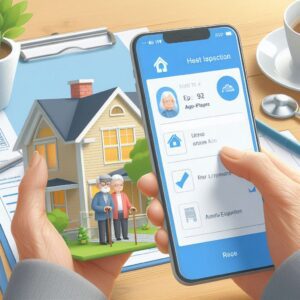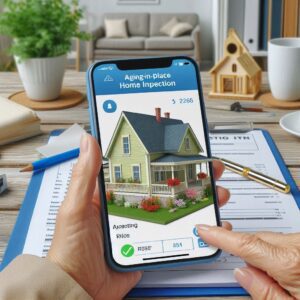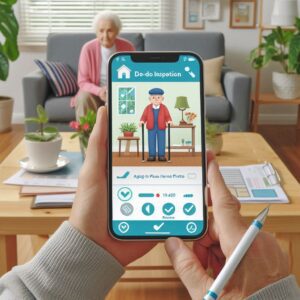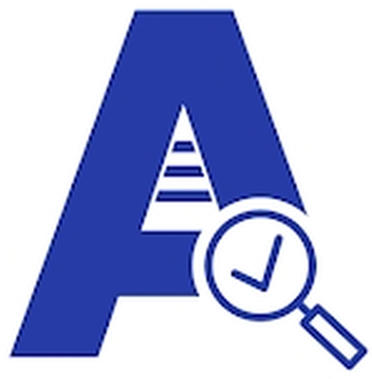Aging-in-place HomeFit To-Do
Creating a Aging-in-place HomeFit To-Do List using eAuditor Audits & Inspections is an excellent way to systematically plan and track tasks that ensure your home is safe, accessible, and comfortable for its occupants, particularly for elderly individuals, those with disabilities, or anyone requiring home modifications. eAuditor Audits & Inspections allows you to build a checklist of tasks, assign responsibilities, and track progress.

Here’s a step-by-step guide on how to create and manage a Home Fit To-Do List using eAuditor Audits & Inspections:
1. Set Up eAuditor Audits & Inspections
- Download and Install eAuditor Audits & Inspections from the App Store or Google Play.
- Create an Account: Log in or sign up to use eAuditor Audits & Inspections.
- Explore Templates: Search for Aging-in-place HomeFit To-Do templates related to home safety, home accessibility, or home modification, or start a new Aging-in-place HomeFit To-Do checklist from scratch.
2. Create a Home Fit To-Do List Template
Start by setting up a custom checklist in eAuditor Audits & Inspections for home tasks related to accessibility, safety, and modifications. Organize tasks by areas of the home.
Common Categories for a Aging-in-place HomeFit To-Do:
- Entrances & Exits
- Hallways & Corridors
- Living Room
- Bathroom
- Bedroom
- Kitchen
- Stairs
- Lighting
- Outdoor Areas
- Emergency Equipment
3. Key Tasks to Include in Your Home Fit To-Do List
Break down the checklist by room or safety category, ensuring that all areas of the home are considered.
a. Entrances & Exits
- Widen doorways to a minimum of 32 inches for wheelchair access.
- Install ramps or stairlifts where necessary.
- Ensure outdoor walkways are free of debris and slip-resistant.
- Install lever-style handles on doors for easier opening.
- Ensure proper lighting at all entry points, including motion-sensor lights.
b. Hallways & Corridors
- Remove any clutter to ensure clear walking paths.
- Install grab bars along hallways for support.
- Check that flooring is smooth and non-slip.
- Ensure adequate lighting in all hallways.
c. Living Room
- Rearrange furniture to allow for clear passage, especially for wheelchairs or walkers.
- Secure area rugs to prevent slipping.
- Replace low, deep seating with chairs that have armrests and proper support.
- Ensure remote controls, light switches, and devices are accessible from seated positions.
d. Bathroom
- Install grab bars near the toilet, tub, and shower.
- Add non-slip mats in the shower and around the bathroom floor.
- Raise the toilet seat for ease of use.
- Install a walk-in shower or bathtub with a door for easy access.
- Ensure faucets are easy to operate (single lever preferred).
e. Bedroom
- Ensure bed height is comfortable to get in and out of.
- Install bed rails if necessary for safety.
- Make sure there is clear space around the bed for mobility aids.
- Place light switches and nightlights within reach from the bed.
f. Kitchen
- Lower countertops and cabinets for easy access.
- Install pull-out shelves and lazy susans in cabinets for easier reach.
- Make sure stove controls are at the front for easy access without reaching over hot surfaces.
- Secure heavy kitchen appliances and store them at waist level for accessibility.
g. Stairs
- Install sturdy handrails on both sides of stairs.
- Ensure each step has non-slip treads.
- Install a stairlift if necessary.
- Ensure stairways are well-lit, with light switches at both the top and bottom.
h. Lighting
- Replace standard light switches with rocker switches or motion-sensor lighting.
- Install bright, energy-efficient bulbs in all rooms.
- Add nightlights in hallways, bathrooms, and bedrooms.
- Ensure there is adequate outdoor lighting for paths, entrances, and stairways.
i. Outdoor Areas
- Level outdoor pathways to prevent tripping.
- Install ramps where necessary.
- Ensure garden hoses and tools are safely stored.
- Inspect outdoor steps for damage and repair as needed.
- Check outdoor handrails for stability.
j. Emergency Equipment
- Install smoke alarms and test them monthly.
- Install carbon monoxide detectors.
- Ensure fire extinguishers are in accessible locations.
- Create a clear emergency exit plan, with escape routes.
- Prepare an emergency kit with essentials such as first aid supplies, flashlights, and medications.


4. Assign Responsibilities
eAuditor Audits & Inspections allows you to assign specific tasks to family members, caregivers, or professionals. Each item in the checklist can have:
- Assigned personnel for completion (e.g., contractor for ramp installation).
- Due dates to ensure timely completion.
- Reminders to notify users of upcoming deadlines or overdue tasks.
5. Add Details and Notes
For each item on your Home Fit To-Do list, you can:
- Attach photos using eAuditor Audits & Inspection’s camera feature, documenting the current state or areas needing work.
- Add comments or instructions for more complex tasks, such as the type of grab bars to be installed or specifications for a wheelchair ramp.
6. Monitor Progress
- Track Completed Tasks: As tasks are completed, mark them off the checklist in eAuditor Audits & Inspections to track progress.
- Set Up Recurring Tasks: Certain safety checks, like testing alarms or inspecting handrails, may need to be done regularly. eAuditor Audits & Inspections allows you to set up recurring tasks.
7. Generate Reports
eAuditor Audits & Inspections enables you to export reports on completed or pending tasks:
- Share with Contractors or Family Members: Generate a PDF from Aging-in-place HomeFit To-Do Checklist of the to-do list to share with professionals or others involved in making home modifications.
- Track Long-Term Improvements: Keep a log of completed tasks to measure progress over time.
8. Adjust and Improve the Checklist
The needs of the household may evolve over time. Review and update the Home Fit To-Do List regularly to:
- Adapt to New Needs: Add new items if mobility needs or other safety requirements change.
- Prioritize Tasks: Mark critical tasks that should be completed first, such as installing grab bars or fixing stairway issues.


By using eAuditor Audits & Inspections for your Home Fit To-Do List, you can stay organized, delegate responsibilities, and ensure all tasks are tracked and completed efficiently. This systematic approach helps ensure your home remains safe, accessible, and comfortable for all residents.
